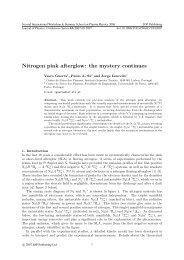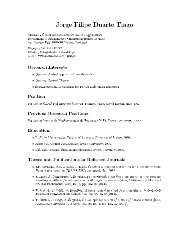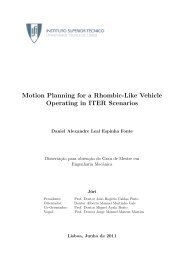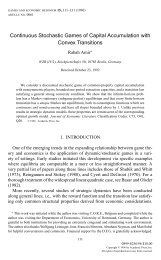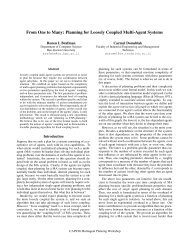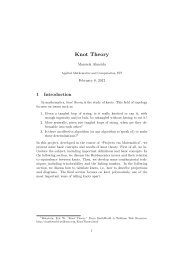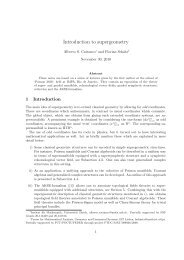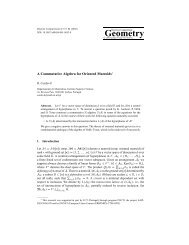Two alternative derivations of Bridgman's theorem
Two alternative derivations of Bridgman's theorem
Two alternative derivations of Bridgman's theorem
Create successful ePaper yourself
Turn your PDF publications into a flip-book with our unique Google optimized e-Paper software.
258 M.N. Berberan-Santos, L. Pogliani / Bridgman’s <strong>theorem</strong>One then obtains from equations (3)–(5) thatm ( Q ′ | U ′) U ′ = f [ m(Q | U)U ] . (6)It is also true that equation (6) holds for the pure numerical part <strong>of</strong> the quantities,Insertion <strong>of</strong> equation (7) into equation (6) yieldsm ( Q ′ | U ′) = f [ m(Q | U) ] . (7)f [ m(Q | U) ] U ′ = f [ m(Q | U)U ] . (8)For the particular case Q = U one has m(Q | U) = 1, and from equation (8),U ′ = f(U)f(1) , (9)a result that holds for any value <strong>of</strong> Q. Insertion <strong>of</strong> equation (9) into equation (8) finallygivesf [ m(Q | U) ] f(U)f(1) = f[ m(Q | U)U ] . (10)If Q is dimensionless (U ≡ 1), equation (10) is always obeyed, regardless <strong>of</strong> the form<strong>of</strong> function f.However, if Q has dimensions, not all functions satisfy equation (10). Thisequation can be rewritten asf(xy) = f(x)f(y) , (11)f(1)whose general solution is seen to bef(x) = αx β , (12)where α is a dimensional or dimensionless constant and β is a pure number. This isthe one-variable form <strong>of</strong> Bridgman’s <strong>theorem</strong>.4.2. Second pro<strong>of</strong>Here we apply the principle <strong>of</strong> dimensional homogeneity to a Taylor series expansion<strong>of</strong> a general function f(x),f(x) = f(a) + (x − a) df(x − a)2 d 2 ∣f ∣∣∣adx ∣ +a2 dx 2 + ···. (13)
M.N. Berberan-Santos, L. Pogliani / Bridgman’s <strong>theorem</strong> 259According to the principle <strong>of</strong> dimensional homogeneity, both members <strong>of</strong> equation (13)must have the same dimensions, the same being true <strong>of</strong> every term. This will happenif[ ] df[f] = [x] , (14)dx[f] = [ x 2][ d 2 ] [ ( )]f d dfdx 2 = [x] 2 , (15)dx dx.where the square brackets stand, as usual, for “dimensions <strong>of</strong>”. Equalities (14)–(15)will hold if[ ] df= [f]dx [x] , (16)[ ( )] d df= [f]dx dx [x] 2 , (17)But equation (16) can be rewritten as[ ] df= [f] [ ] fdx [x] = . (18)xSince these relations must be valid for any x, they imply thatdfdx = β f x , (19)where β is a dimensionless constant. The solution <strong>of</strong> equation (19) is.f(x) = αx β , (20)where α is again a dimensional or dimensionless constant. Equation (20) also satisfiesthe higher terms conditions (equation (17), etc.).5. General resultsThe answer to the second (and more general) question is that the final form<strong>of</strong> the derived quantity must again be like equation (1), and therefore only products<strong>of</strong> powers <strong>of</strong> the quantities can occur, unless some <strong>of</strong> the independent quantities arealgebraically combined to yield dimensionless groups, whose functions are groupedtogether in the factor α <strong>of</strong> equation (1). Dimensionless groups can also be formed withthe participation <strong>of</strong> dimensional constants. These constants may have unit value, andoccur associated with standard states (e.g., in thermodynamics) or definitions (e.g., the
260 M.N. Berberan-Santos, L. Pogliani / Bridgman’s <strong>theorem</strong>definition <strong>of</strong> pH), or may have definite values, and be called physical constants, likethe Boltzmann and Planck constants, and the speed <strong>of</strong> light in the vacuum.For all dimensionless groups, no restrictions on the (dimensionless) functionalform exist, that may be “transcendental to the worst degree” [2, p. 44]. For instance,exponentials and logarithms <strong>of</strong> such groups are common, but much more complexforms are possible and do indeed exist, as a perusal <strong>of</strong> any Handbook <strong>of</strong> Physicsshows. Only their number can be obtained from Dimensional Analysis (Buckingham’sΠ <strong>theorem</strong> [2]).6. Discussion and conclusionsWe now consider two examples taken from the literature where functions otherthan powers have dimensional arguments.The first example is the Arrhenius equation for the rate <strong>of</strong> a chemical reaction,k = A exp(−E a /RT ), where k is the rate constant, A the frequency factor, E a theenergy <strong>of</strong> activation, R is the perfect gas constant, and T is the temperature. For thepurpose <strong>of</strong> evaluating A and E a from experimental data, the equation is frequentlylinearized in the form ln k = ln A − E a /RT . None <strong>of</strong> the two logarithms is correctper se, as discussed. Therefore, if a meaning is to be attributed to individual terms inthe expression above, the arguments <strong>of</strong> the logarithms must be made dimensionless,and the equation written as ln(k/k 0 ) = ln(A/k 0 ) − E a /RT , k 0 being the unit rateconstant in the chosen units. This is in fact what is done when the logarithms <strong>of</strong> theexperimental quantities are calculated: only the number is used, not the associatedunits. On the other hand, if the quantities (pure number times unit) are used directlyin ln k = ln A − E a /RT , logarithms <strong>of</strong> the units appear on both sides. No meaningcan be attributed to these. Nevertheless, a cancellation <strong>of</strong> terms occurs, the logarithms<strong>of</strong> the units disappear, and the final result is the same. All reduces in this case to amatter <strong>of</strong> formal rigor.The second example is the chemical potential <strong>of</strong> a perfect gas, sometimes writtenas µ = µ 0 + RT ln p, whereµ 0 = µ(p 0 , T ) is the chemical potential <strong>of</strong> the standardstate, p 0 being the pressure <strong>of</strong> the standard state, R is the perfect gas constant, T is thetemperature and p is the pressure. The fault is in this case that pressure is implicitlyassumed to be given in a certain unit, usually the bar. The equation should in fact beµ = µ 0 + RT ln(p/p 0 ). In this second example, the situation is more serious, and theequation is indeed dimensionally incorrect.In conclusion, problems that occur with dimensional arguments result either froma lack <strong>of</strong> formal rigor or from dimensionally incorrect expressions, that can only becorrectly understood if accompanied by a sentence stating which units are to be used.This amounts to divide the respective quantities by such units, thus rendering themdimensionless. No harm usually results, but the practice is confusing and unnecessary.Computational errors may also be the outcome <strong>of</strong> such a procedure.In this work, Bridgman’s <strong>theorem</strong> was rederived in two new ways, and its significancewas discussed.
M.N. Berberan-Santos, L. Pogliani / Bridgman’s <strong>theorem</strong> 261Appendix: Original pro<strong>of</strong> <strong>of</strong> Bridgman’s <strong>theorem</strong>We give here the one-variable pro<strong>of</strong>. The generalization to n variables is straighforward[2]. LetQ ′ = f(Q).(A1)Let the unit <strong>of</strong> Q to be U. Take two different numerical values <strong>of</strong> Q, m 1 and m 2 .If the unit <strong>of</strong> Q, U, is now changed to U/x, then the numerical values <strong>of</strong> Q becomexm 1 and xm 2 . The following relation must clearly hold:f(m 1 )f(m 2 ) = f(xm 1)f(xm 2 ) .(A2)This equation can be rewritten asf(xm 1 ) = f(m 1)f(m 2 ) f(xm 2).(A3)Differentiation with respect to x yieldsm 1 f(xm ˙ 1 ) = f(m 1)f(m 2 ) m 2f(xm ˙ 2 ),(A4)where the dot represents the derivative <strong>of</strong> the function with respect to the argument.Making now x = 1, one getsf(m ˙ 1 )m 1f(m 1 ) = m f(m ˙ 2 )2f(m 2 ) .(A5)Because this equation must apply to any m 1 and m 2 , it implies the differential equationf(m)m ˙f(m) = β,(A6)where β is some pure number. The solution <strong>of</strong> equation (A6) isf(m) = αm β ,where α is a dimensional or dimensionless constant and β is a pure number.(A7)References[1] BIPM, Le Système International d’unités (BIPM, Sèvres, 1998). See also http://www.bipm.fr.[2] P.W. Bridgman, Dimensional Analysis (Yale University Press, New Haven, 1931).[3] J.C. Gibbings, On dimensional analysis, J. Phys. A 13 (1980) 75–89.[4] E.A. Guggenheim and J.E. Prue, Physicochemical Calculations (North-Holland, Amsterdam, 1955).[5] D.E. Smith, A Sourcebook in Mathematics (Dover, New York, 1959).[6] M.A. White, Quantity calculus: Unambiguous designation <strong>of</strong> units in graphs and tables, J. Chem.Educ. 75 (1998) 607–609.






